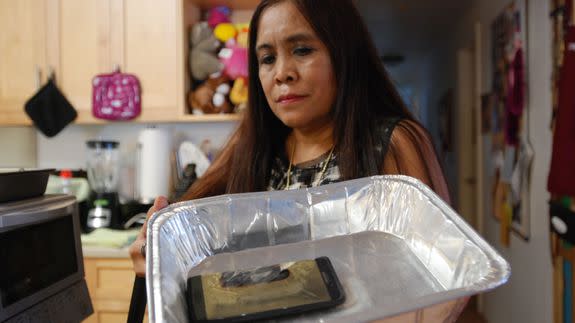Here's what to do if your smartphone's battery starts smoking

As more and more reports of failing Samsung Galaxy Note7 devices crop up, so, too, do videos of smoking smartphones — a terrifying sight for the vast majority of users.
What you'll notice in some of these videos is the sight of people handling the failing device as thought it's a hot plate of pasta instead of a very dangerous battery that could explode at any moment.
SEE ALSO: New Gear VR headsets no longer work with Samsung's Galaxy Note7
So what should you do if your Note7 (or any other mobile device powered by a lithium ion battery) starts smoking? We asked a couple of the top experts and their answers are, in some cases, obvious — others were quite surprising.
DO
Get away: "The best thing to do is to stand back and let the device burn or smoke — you cannot stop it once it begins," Jeff Dahn, a professor of physics and atmospheric science at Canada's Dalhousie University who is currently working with Tesla on battery technology, told Mashable. "The fumes contain toxic gases so you do not want to breathe those."
That's the same advice given by electrical engineer John Drengenberg, who also serves as the consumer safety director at UL (Underwriters Laboratories), an organization that tests many of the electrical devices in our homes.
"The most conservative thing you can do is don’t breathe the fumes and call the fire department for help," Drengenberg told Mashable. "Especially if you’re pregnant, a very young child or very old. This is not smoke from a bonfire, this is a chemical reaction that is emitting toxic materials."
DON'T
Extinguish the fire: Contrary to what your instincts might tell you, attempting to put a lithium ion battery fire out like a normal fire might cause more trouble. "Best thing to do is push the device into a bucket of sand," Dahn says, jokingly noting that no one walks around with a bucket of sand on hand. On a more serious note, Drengenberg warns against dousing the device with water or using a fire extinguisher, two actions that might exacerbate the battery's chemical reaction. He also warns against attempting to smother the device with another material.
"It's a little bit like a grenade, once you pull the pain it's going to do something," said Drengenberg. "The only thing you can do is get out of the way."
Move the device: "You don’t want to pick it up because you could be injured by a chemical burn," says Drengenberg. However, if you do decide to move the device by hand, and happen to have flame retardant gloves around, he advises that you wear a respirator to avoid inhaling the fumes.
Where to move it, if you must: "It is important not to let the fire spread to other items (papers, house, whatever)," says Dahn. "So putting the phone on a non-combustible surface is a good thing." Drengenberg suggests an even better solution: "If you have a metal container of some kind and put it in there with a spatula, that would be a good course," he says. "But most people don’t have such a container around."
But despite the aforementioned warnings, the good news is that lithium ion batteries are, for the most part, safe.
"Of the roughly 3.5 to 4 billion lithium ion batteries out there, the failures are about one in 10 million," says Drengenberg. "So it's not common."
As for the way forward with lithium ion battery-powered wearables and mobile devices, he thinks the current battery technology is just fine.
"We consumers, we all want our laptop and phones to last for many hours, and the only chemistry that gives us all that energy in these small devices at this time is lithium ion," says Drengenberg. "They are safe, and [UL has] a standard for testing lithium ion batteries. I wouldn’t worry about them too much."

 Yahoo News
Yahoo News 